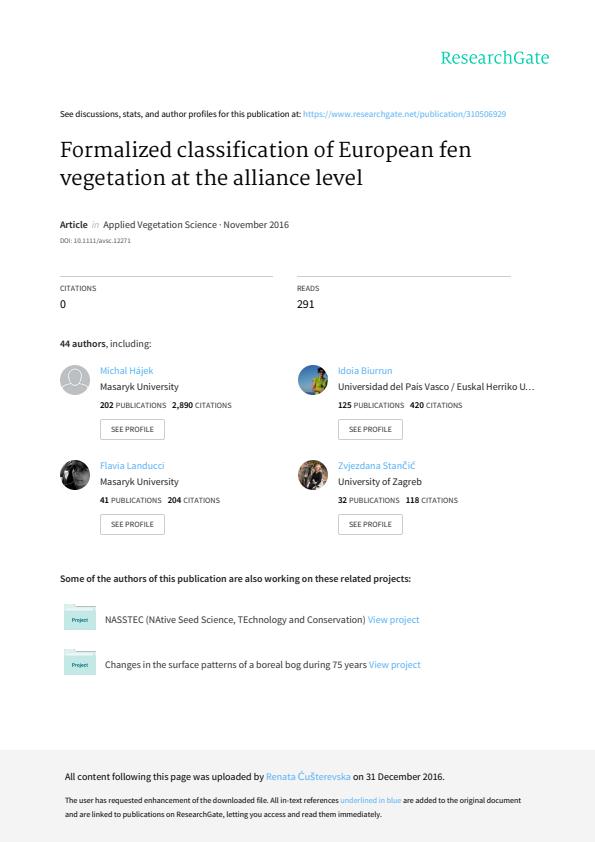Formalized classification of European fen vegetation at the alliance level
Location: Europe, western Siberia and south-eastern Greenland.
Methods: 29 049 vegetation-plot records of fens were selected using a list of specialist fen species. Formal definitions of alliances were created using the presence, absence and abundance of Cocktail-based species groups and indicator species. DCA visualized the similarities among the alliances in an ordination space. The ISOPAM algorithm was applied to regional subsets with homogeneous plot size to check whether the classification based on formal definitions matches the results of unsupervised classifications.
Results: The following alliances were defined: Caricion viridulo-trinervis (sub-halophytic Atlantic dune-slack fens), Caricion davallianae (temperate calcareous fens), Caricion atrofusco-saxatilis (arcto-alpine calcareous fens), Stygio-Caricion limosae (boreal topogenic brown-moss fens), Sphagno warnstorfii-Tomentypnion nitentis (Sphagnum-brown-moss rich fens), Saxifrago-Tomentypnion (continental to boreo-continental nitrogen-limited brown-moss rich fens), Narthecion scardici (alpine fens with Balkan endemics), Caricion stantis (arctic brown-moss rich fens), Anagallido tenellae-Juncion bulbosi (Ibero-Atlantic moderately rich fens), Drepanocladion exannulati (arcto-boreal-alpine non-calcareous fens), Caricion fuscae (temperate moderately rich fens), Sphagno-Caricion canescentis (poor fens) and Scheuchzerion palustris (dystrophic hollows). The main variation in the species composition of European fens reflected site chemistry (pH, mineral richness) and sorted the plots from calcareous and extremely rich fens, through rich and moderately rich fens, to poor fens and dystrophic hollows. ISOPAM classified regional subsets according to this gradient, illustrating the ecological meaningfulness of this classification concept on both the regional and continental scale. Geographical/macroclimatic variation was reflected in the second most important gradient.
Conclusions: The pan-European classification of fen vegetation was proposed. Formal definitions developed here allow consistent and unequivocal assignment of individual vegetation plots to fen alliances at the continental scale.
Details
| Aantal pagina's | 20 |
|---|---|
| Volume | 20 |
| Tijdschrift nummer | 1 |
| Pagina's (van-tot) | 124-142 |
| Type | A1: Web of Science-artikel |
| Categorie | Onderzoek |
| Tijdschrift | Applied Vegetation Science |
| Issns | 1402-2001|1654-109X |
| Uitgeverij | Opulus |
| Taal | Engels |
Bibtex
@misc{c934c548-b2b7-4b91-bc5e-657556cb8fc4,
title = "Formalized classification of European fen vegetation at the alliance level",
abstract = "Aims: Phytosociological classification of fen vegetation (Scheuchzerio palustris-Caricetea fuscae class) differs among European countries. Here we propose a unified vegetation classification of European fens at the alliance level to provide unequivocal assignment rules for individual vegetation plots, to identify diagnostic species of fen alliances, and to map their distribution.
Location: Europe, western Siberia and south-eastern Greenland.
Methods: 29 049 vegetation-plot records of fens were selected using a list of specialist fen species. Formal definitions of alliances were created using the presence, absence and abundance of Cocktail-based species groups and indicator species. DCA visualized the similarities among the alliances in an ordination space. The ISOPAM algorithm was applied to regional subsets with homogeneous plot size to check whether the classification based on formal definitions matches the results of unsupervised classifications.
Results: The following alliances were defined: Caricion viridulo-trinervis (sub-halophytic Atlantic dune-slack fens), Caricion davallianae (temperate calcareous fens), Caricion atrofusco-saxatilis (arcto-alpine calcareous fens), Stygio-Caricion limosae (boreal topogenic brown-moss fens), Sphagno warnstorfii-Tomentypnion nitentis (Sphagnum-brown-moss rich fens), Saxifrago-Tomentypnion (continental to boreo-continental nitrogen-limited brown-moss rich fens), Narthecion scardici (alpine fens with Balkan endemics), Caricion stantis (arctic brown-moss rich fens), Anagallido tenellae-Juncion bulbosi (Ibero-Atlantic moderately rich fens), Drepanocladion exannulati (arcto-boreal-alpine non-calcareous fens), Caricion fuscae (temperate moderately rich fens), Sphagno-Caricion canescentis (poor fens) and Scheuchzerion palustris (dystrophic hollows). The main variation in the species composition of European fens reflected site chemistry (pH, mineral richness) and sorted the plots from calcareous and extremely rich fens, through rich and moderately rich fens, to poor fens and dystrophic hollows. ISOPAM classified regional subsets according to this gradient, illustrating the ecological meaningfulness of this classification concept on both the regional and continental scale. Geographical/macroclimatic variation was reflected in the second most important gradient.
Conclusions: The pan-European classification of fen vegetation was proposed. Formal definitions developed here allow consistent and unequivocal assignment of individual vegetation plots to fen alliances at the continental scale.
",
author = "Tomas Peterka and Michal Hajek and Martin Jirousek and Borja Jiménez-Alfaro and Liene Aunina and Ariel Bergamini and Daniel Dité and Ljuba Felbaba-Klushyna and Ulrich Graf and Petra Hajkova and Eva Hettenbergerova and Tatiana G. Ivchenko and Florian Jansen and Natalia E. Koroleva and Elena D. Lapshina and Pedrag M. Lazarevic and Asbjorn Moen and Maxim G. Napreenko and Pawel Pawlikowski and Zuzana Pleskova and Lucia Sekulova and Viktor A. Smagin and Temuu Tahvanainen and Annett Thiele and Claudia Bita-Nicolae and Idoia Biurrun and Henry Brisse and Renata Custerevska and Els De Bie and Jorg Ewald and Una FitzPatrick and Zygmunt Kacki and Anna Kuzemko and Flavia Landucci and Jesper E. Moeslund and Aaron Pérez-Haase and Valerijus Rasomavicius and John S. Rodwell and Joop H.J. Schaminée and Urban Silc and Zvjezdana Stancic and Milan Chytry",
year = "2016",
month = nov,
day = "01",
doi = "https://doi.org/10.1111/avsc.12271",
language = "Nederlands",
publisher = "Opulus",
address = "België,
type = "Other"
}
Auteurs
Tomas PeterkaMichal Hajek
Martin Jirousek
Borja Jiménez-Alfaro
Liene Aunina
Ariel Bergamini
Daniel Dité
Ljuba Felbaba-Klushyna
Ulrich Graf
Petra Hajkova
Eva Hettenbergerova
Tatiana G. Ivchenko
Florian Jansen
Natalia E. Koroleva
Elena D. Lapshina
Pedrag M. Lazarevic
Asbjorn Moen
Maxim G. Napreenko
Pawel Pawlikowski
Zuzana Pleskova
Lucia Sekulova
Viktor A. Smagin
Temuu Tahvanainen
Annett Thiele
Claudia Bita-Nicolae
Idoia Biurrun
Henry Brisse
Renata Custerevska
Els De Bie
Jorg Ewald
Una FitzPatrick
Zygmunt Kacki
Anna Kuzemko
Flavia Landucci
Jesper E. Moeslund
Aaron Pérez-Haase
Valerijus Rasomavicius
John S. Rodwell
Joop H.J. Schaminée
Urban Silc
Zvjezdana Stancic
Milan Chytry

